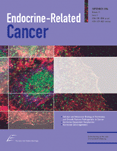| HOME | HELP | FEEDBACK | SUBSCRIPTIONS | ARCHIVE | SEARCH | TABLE OF CONTENTS |
|
|
||||||||
1 Instituto de Investigaciones Biomédicas ‘Alberto Sols’,, Consejo Superior de Investigaciones Científicas y Universidad Autónoma de Madrid (CSIC-UAM), 28029 Madrid, Spain 2 Servicio de Endocrinología y Nutrición,, Hospital Universitario La Paz, Madrid, Spain
(Correspondence should be addressed to P Santisteban; Email: psantisteban{at}iib.uam.es)
Well-differentiated thyroid cancer has in general terms a very good outcome. It has a very slow growth rate and, although it metastasises at a relatively high frequency, it has very high survival rates. Whereas the prevalence of nodular thyroid disease worldwide is high, malignant conversion from benign thyroid nodules is rare. Treatment of thyroid cancer is usually successful, but we still do not have effective therapies for patients with invasive or metastatic thyroid cancer if the disease does not concentrate radioiodine and it is not surgically resectable. On the other hand, from the same thyroid cell, one of the most aggressive human tumours can arise - undifferentiated or anaplastic thyroid carcinoma - leading to death in a few months. What features of this malignancy account for such paradoxical behaviour? The most common type of thyroid cancer - papillary thyroid carcinoma - stands out among solid tumours because many of the tumour-initiating events have been identified. All of them function in a single pathway - the RTK/RAS/RAF/MAPK pathway - and obey an ‘exclusivity principle’: one and only one component of the pathway is mutated in a single tumour. This highlights the requirement of this signal transduction pathway for the transformation to thyroid cancer and paves the way to targeted therapies against a tumour with a mutation in a known gene or any gene upstream of the target. However, it is also interesting to underscore the differences among the tumours arising from the different mutations. Studies in vitro and in vivo, including genomic profiling and genetically engineered mouse models, have clearly shown that each oncoprotein exerts its own oncogenic drive, conferring a distinct biological behaviour on thyroid tumours. In this review, we attempt to summarise the most recent advances in thyroid follicular cell-derived cancers research and their potential clinical impact that may change the management of thyroid cancer in the near future.
This article has been cited by other articles:
 |
M. LANDRISCINA, F. MADDALENA, A. FABIANO, A. PISCAZZI, O. LA MACCHIA, and M. CIGNARELLI Erlotinib Enhances the Proapoptotic Activity of Cytotoxic Agents and Synergizes with Paclitaxel in Poorly-differentiated Thyroid Carcinoma Cells Anticancer Res, February 1, 2010; 30(2): 473 - 480. [Abstract] [Full Text] [PDF] |
||||
 |
C. J. O'Neill, J. Oucharek, D. Learoyd, and S. B. Sidhu Standard and Emerging Therapies for Metastatic Differentiated Thyroid Cancer Oncologist, February 1, 2010; 15(2): 146 - 156. [Abstract] [Full Text] [PDF] |
||||
 |
M. C. Zatelli, G. Trasforini, S. Leoni, G. Frigato, M. Buratto, F. Tagliati, R. Rossi, L. Cavazzini, E. Roti, and E. C degli Uberti BRAF V600E mutation analysis increases diagnostic accuracy for papillary thyroid carcinoma in fine-needle aspiration biopsies Eur. J. Endocrinol., September 1, 2009; 161(3): 467 - 473. [Abstract] [Full Text] [PDF] |
||||
 |
O. Prante, S. Maschauer, V. Fremont, J. Reinfelder, R. Stoehr, M. Szkudlinski, B. Weintraub, A. Hartmann, and T. Kuwert Regulation of Uptake of 18F-FDG by a Follicular Human Thyroid Cancer Cell Line with Mutation-Activated K-Ras J. Nucl. Med., August 1, 2009; 50(8): 1364 - 1370. [Abstract] [Full Text] [PDF] |
||||
 |
R. C Smallridge, L. A Marlow, and J. A Copland Anaplastic thyroid cancer: molecular pathogenesis and emerging therapies Endocr. Relat. Cancer, March 1, 2009; 16(1): 17 - 44. [Abstract] [Full Text] [PDF] |
||||
 |
A. Dardano, S. Falzoni, N. Caraccio, A. Polini, S. Tognini, A. Solini, P. Berti, F. D. Virgilio, and F. Monzani 1513A>C Polymorphism in the P2X7 Receptor Gene in Patients with Papillary Thyroid Cancer: Correlation with Histological Variants and Clinical Parameters J. Clin. Endocrinol. Metab., February 1, 2009; 94(2): 695 - 698. [Abstract] [Full Text] [PDF] |
||||
| HOME | HELP | FEEDBACK | SUBSCRIPTIONS | ARCHIVE | SEARCH | TABLE OF CONTENTS |